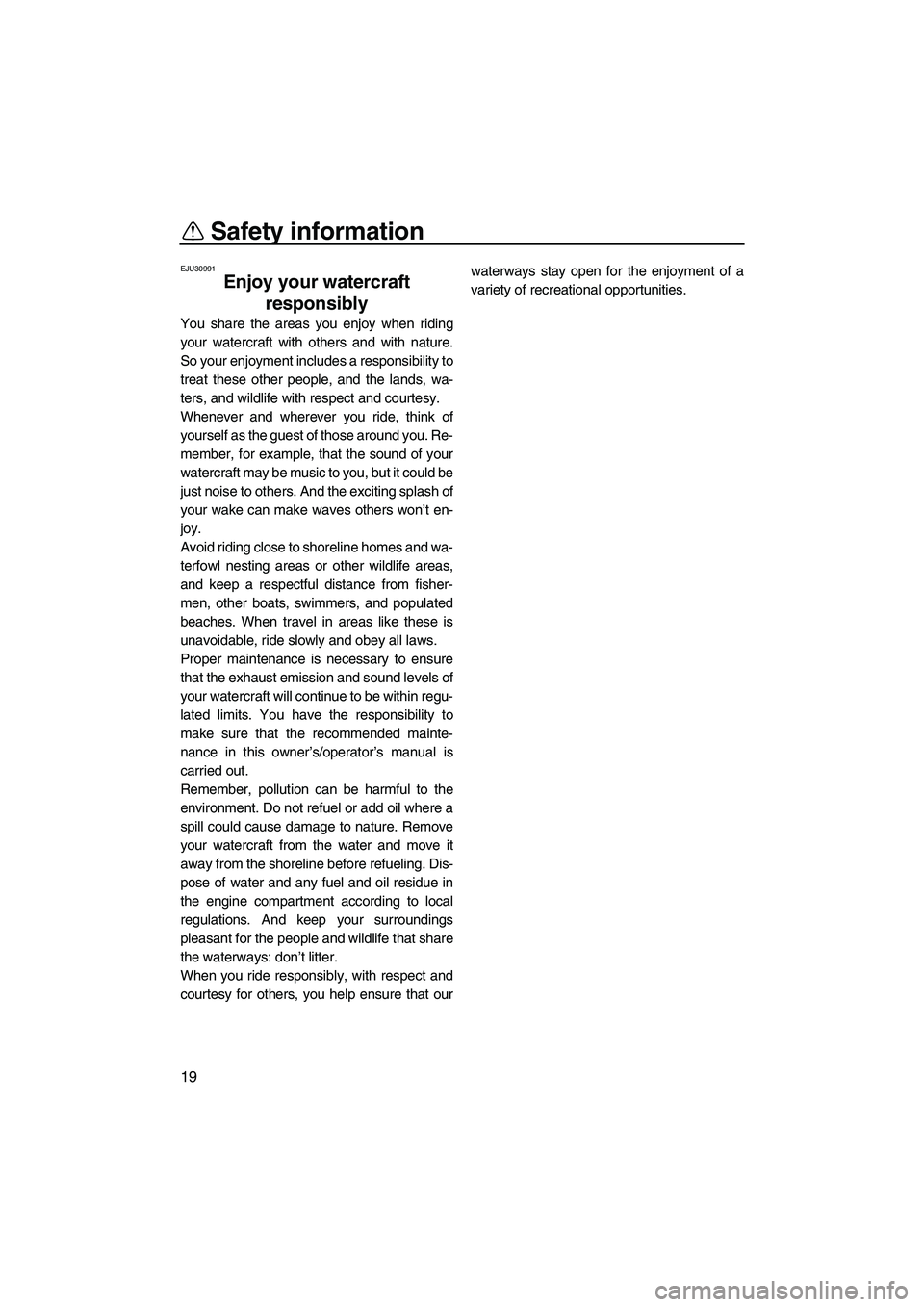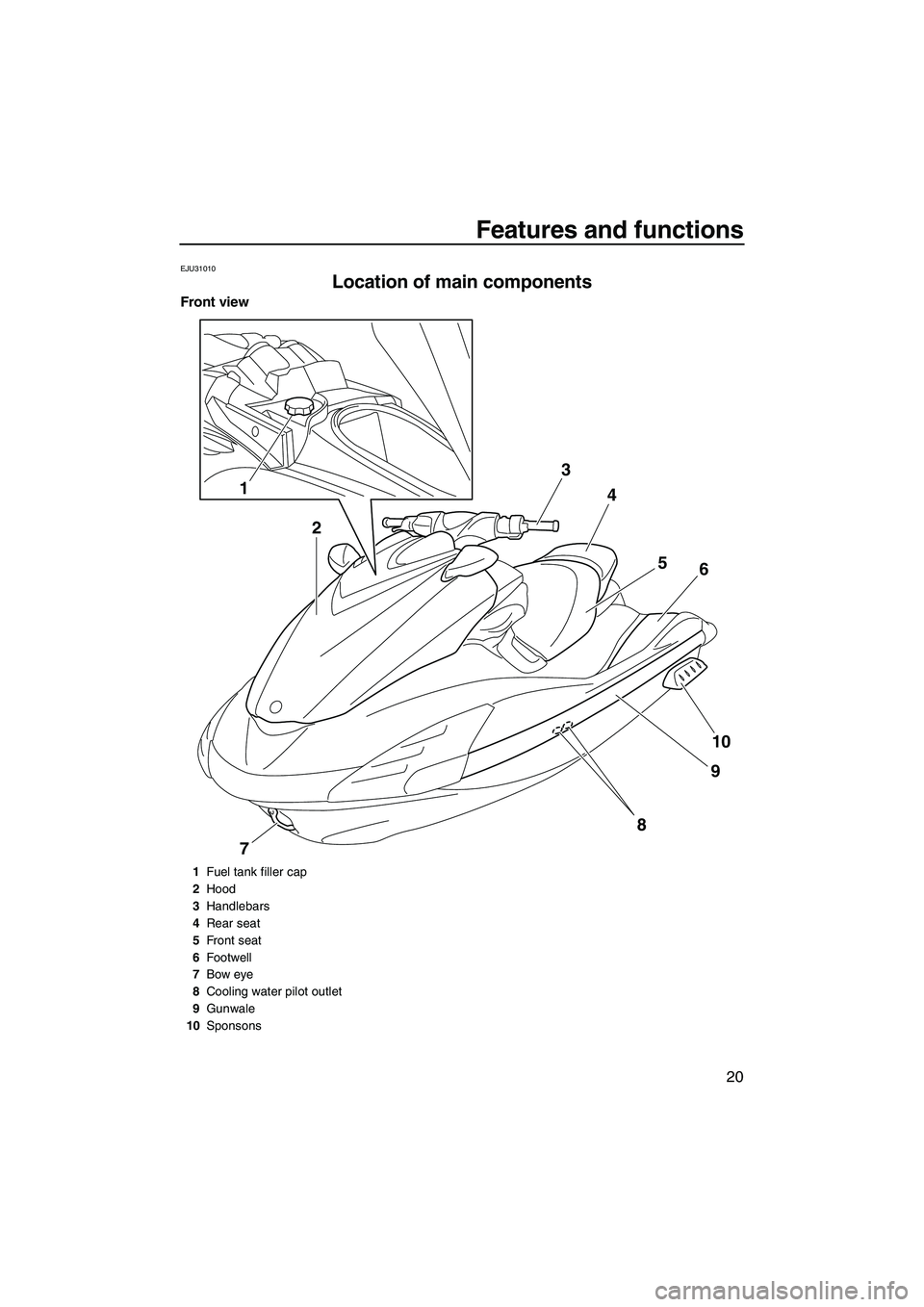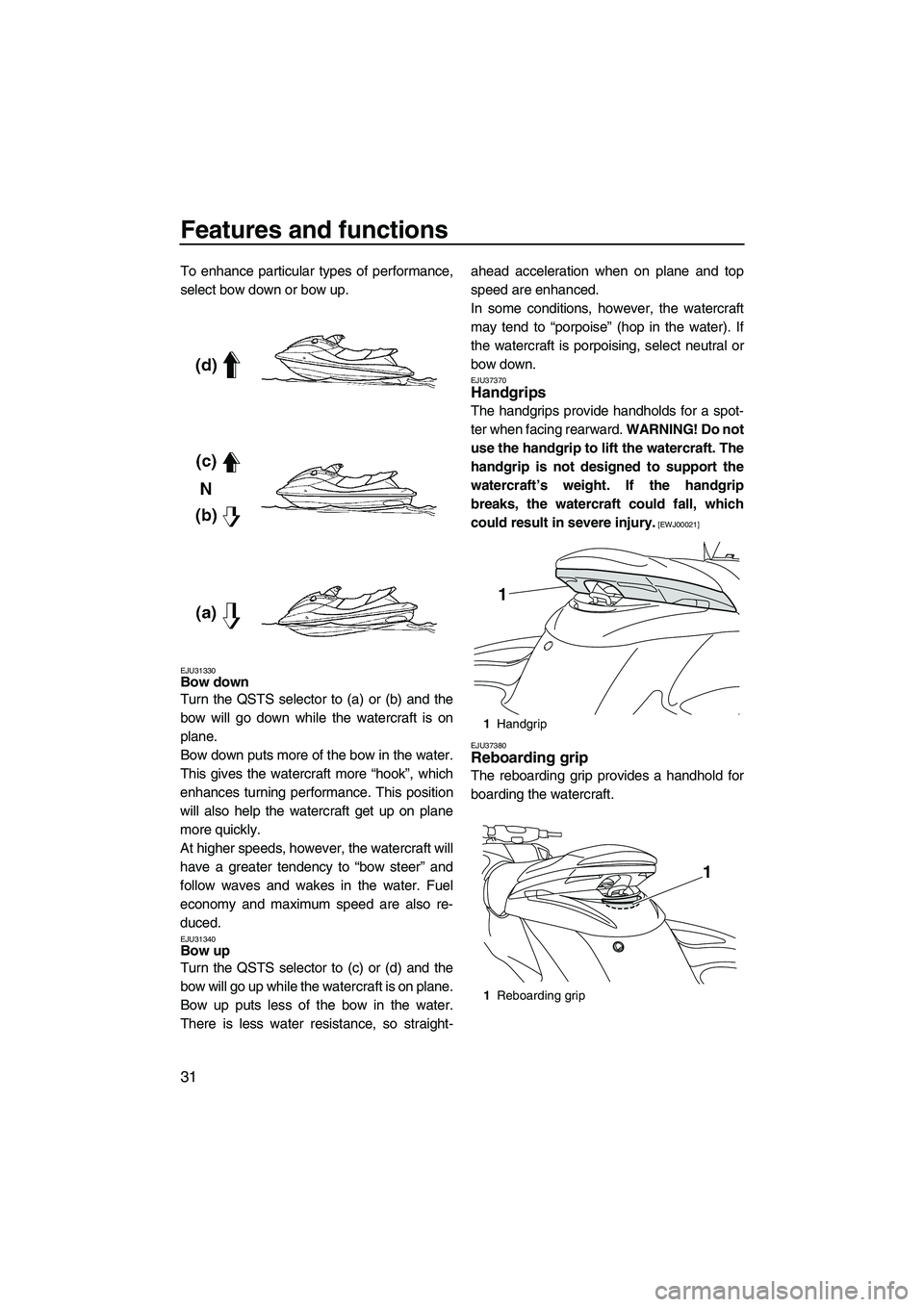2009 YAMAHA FZS fuel
[x] Cancel search: fuelPage 6 of 98

Table of contents
General and important labels ........... 1
Identification numbers .................... 1
Primary Identification (PRI-ID)
number ........................................... 1
Craft Identification Number (CIN) ...... 1
Engine serial number ........................ 1
Model information ........................... 2
Builder’s plate .................................... 2
Important labels .............................. 3
Warning labels ................................... 4
Other labels ....................................... 8
Safety information ........................... 10
Limitations on who may operate
the watercraft ............................ 10
Cruising limitations ....................... 11
Operation requirements ............... 12
Recommended equipment ........... 14
Hazard information ....................... 15
Watercraft characteristics ............. 15
Water-skiing ................................. 17
Safe boating rules ........................ 18
Enjoy your watercraft
responsibly ................................ 19
Features and functions ................... 20
Location of main components ...... 20
Operation of controls and other
functions .................................... 24
Seats ............................................... 24
Hood ................................................ 25
Fuel tank filler cap ........................... 25
Remote control transmitter .............. 25
Engine stop switch .......................... 26
Engine shut-off switch ..................... 26
Start switch ...................................... 27
Throttle lever ................................... 27
Cooling water pilot outlets ............... 28
Steering system ............................... 28
Telescopic steering system ............. 29
Shift lever ........................................ 29
Quick Shift Trim System (QSTS)
selector ........................................ 30Handgrips ........................................ 31
Reboarding grip ............................... 31
Reboarding step .............................. 32
Bow eye ........................................... 32
Stern eyes ....................................... 32
Yamaha Security System ................ 32
Dual analog meter unit .................... 35
Storage compartments .................... 39
Operation ......................................... 43
Fuel and oil .................................. 43
Fuel ................................................. 43
Engine oil ......................................... 44
Pre-operation checks ................... 45
Pre-operation check list ................... 45
Pre-operation check points .............. 47
Operation ..................................... 55
Engine break-in ............................... 55
Launching the watercraft ................. 55
Starting the engine .......................... 55
Stopping the engine ........................ 56
Shifting ............................................ 57
Leaving the watercraft ..................... 57
Operating your watercraft ............ 58
Getting to know your watercraft ....... 58
Learning to operate your
watercraft ..................................... 58
Riding with passengers ................... 59
Starting the watercraft ..................... 59
Boarding and starting in deep
water ............................................ 60
Capsized watercraft ......................... 63
Turning the watercraft ..................... 64
Stopping the watercraft ................... 65
Beaching the watercraft ................... 66
Docking the watercraft ..................... 66
Reverse on waterways .................... 66
Operating in weeded areas ............. 67
Post-operation care ...................... 67
Transporting ................................. 68
Maintenance and care .................... 69
Storage ........................................ 69
Flushing the cooling system ............ 69
UF2C70E0.book Page 1 Monday, November 3, 2008 10:16 AM
Page 7 of 98

Table of contents
Lubrication ....................................... 70
Battery ............................................. 70
Cleaning the watercraft ................... 70
Maintenance and adjustments ..... 71
Owner’s/operator’s manual and
tool kit ........................................... 71
Periodic maintenance chart ............. 72
Checking the fuel system ................ 74
Engine oil and oil filter ..................... 74
Air filter element .............................. 74
Checking the jet thrust nozzle
angle ............................................ 74
Checking the shift cable .................. 75
Checking the throttle lever ............... 75
Cleaning and adjusting the spark
plugs ............................................ 76
Lubrication points ............................ 77
Checking the battery ....................... 78
Fuel injection system ....................... 80
Specifications .................................. 81
Specifications ................................ 81
Trouble recovery ............................. 82
Troubleshooting ........................... 82
Troubleshooting chart ...................... 82
Emergency procedures ................ 85
Cleaning the jet intake and
impeller ........................................ 85
Jumping the battery ......................... 86
Replacing the fuses ......................... 86
Towing the watercraft ...................... 88
Submerged watercraft ..................... 88
UF2C70E0.book Page 2 Monday, November 3, 2008 10:16 AM
Page 26 of 98

Safety information
19
EJU30991
Enjoy your watercraft
responsibly
You share the areas you enjoy when riding
your watercraft with others and with nature.
So your enjoyment includes a responsibility to
treat these other people, and the lands, wa-
ters, and wildlife with respect and courtesy.
Whenever and wherever you ride, think of
yourself as the guest of those around you. Re-
member, for example, that the sound of your
watercraft may be music to you, but it could be
just noise to others. And the exciting splash of
your wake can make waves others won’t en-
joy.
Avoid riding close to shoreline homes and wa-
terfowl nesting areas or other wildlife areas,
and keep a respectful distance from fisher-
men, other boats, swimmers, and populated
beaches. When travel in areas like these is
unavoidable, ride slowly and obey all laws.
Proper maintenance is necessary to ensure
that the exhaust emission and sound levels of
your watercraft will continue to be within regu-
lated limits. You have the responsibility to
make sure that the recommended mainte-
nance in this owner’s/operator’s manual is
carried out.
Remember, pollution can be harmful to the
environment. Do not refuel or add oil where a
spill could cause damage to nature. Remove
your watercraft from the water and move it
away from the shoreline before refueling. Dis-
pose of water and any fuel and oil residue in
the engine compartment according to local
regulations. And keep your surroundings
pleasant for the people and wildlife that share
the waterways: don’t litter.
When you ride responsibly, with respect and
courtesy for others, you help ensure that ourwaterways stay open for the enjoyment of a
variety of recreational opportunities.
UF2C70E0.book Page 19 Monday, November 3, 2008 10:16 AM
Page 27 of 98

Features and functions
20
EJU31010
Location of main components
Front view
1
23
4
5
6
10
9
8
7
1Fuel tank filler cap
2Hood
3Handlebars
4Rear seat
5Front seat
6Footwell
7Bow eye
8Cooling water pilot outlet
9Gunwale
10Sponsons
UF2C70E0.book Page 20 Monday, November 3, 2008 10:16 AM
Page 30 of 98

Features and functions
23
Engine compartment
123
46 5
910
8
7
1Engine cover
2Air filter case
3Water separator
4Fuel tank
5Battery
6Flushing hose connector
7Electrical box
8Spark plug cap
9Engine oil filler cap
10Dipstick
UF2C70E0.book Page 23 Monday, November 3, 2008 10:16 AM
Page 32 of 98

Features and functions
25
push the rear of the seat down to lock it in
place.
(2) Install the rear seat. Make sure that the
seats are securely installed before oper-
ating the watercraft.
EJU31063Hood
To open the hood, push the hood latch, and
then lift up the hood.To close the hood, push down on the rear of
the hood until it latches securely. Make sure
that the hood is securely closed before oper-
ating the watercraft.
EJU36691Fuel tank filler cap
The fuel tank filler cap is located under the
hood.
To remove the fuel tank filler cap, open the
hood, and then turn the cap counterclockwise.
(See page 25 for hood opening and closing
procedures.)
To install the fuel tank filler cap, turn it clock-
wise until it stops. Make sure that the fuel tank
filler cap and the hood are securely closed be-
fore operating the watercraft.
EJU36621Remote control transmitter
The Yamaha Security System and low-RPM
mode settings are selected using the remote
control transmitter. (See “Yamaha Security1Hood latch
1
1Fuel tank filler cap
1
UF2C70E0.book Page 25 Monday, November 3, 2008 10:16 AM
Page 38 of 98

Features and functions
31
To enhance particular types of performance,
select bow down or bow up.
EJU31330Bow down
Turn the QSTS selector to (a) or (b) and the
bow will go down while the watercraft is on
plane.
Bow down puts more of the bow in the water.
This gives the watercraft more “hook”, which
enhances turning performance. This position
will also help the watercraft get up on plane
more quickly.
At higher speeds, however, the watercraft will
have a greater tendency to “bow steer” and
follow waves and wakes in the water. Fuel
economy and maximum speed are also re-
duced.
EJU31340Bow up
Turn the QSTS selector to (c) or (d) and the
bow will go up while the watercraft is on plane.
Bow up puts less of the bow in the water.
There is less water resistance, so straight-ahead acceleration when on plane and top
speed are enhanced.
In some conditions, however, the watercraft
may tend to “porpoise” (hop in the water). If
the watercraft is porpoising, select neutral or
bow down.
EJU37370Handgrips
The handgrips provide handholds for a spot-
ter when facing rearward. WARNING! Do not
use the handgrip to lift the watercraft. The
handgrip is not designed to support the
watercraft’s weight. If the handgrip
breaks, the watercraft could fall, which
could result in severe injury.
[EWJ00021]
EJU37380
Reboarding grip
The reboarding grip provides a handhold for
boarding the watercraft.
1Handgrip
1Reboarding grip
1
1
UF2C70E0.book Page 31 Monday, November 3, 2008 10:16 AM
Page 43 of 98

Features and functions
36
EJU37250Information display
The information display shows watercraft op-
erating conditions.
EJU37261Hour meter/voltmeter
The hour meter/voltmeter can be used as an
hour meter or a voltmeter.
TIP:
The hour meter is selected at the Yamaha
factory.
Hour meter
The hour meter shows the hours of engine op-
eration that have elapsed since the watercraft
was new.To switch to the hour meter from the voltme-
ter:
Push the “Hour Volt” button for at least 1 sec-
ond. The display switches from the voltmeter
to the hour meter.
Voltmeter
The voltmeter shows the battery voltage.
When the battery voltage is normal, the volt-
meter displays approximately 12 volts.
If the battery voltage has dropped significant-
ly, “LO” is displayed on the voltmeter. If the
battery voltage has risen significantly, “HI” is
displayed. If “HI” or “LO” is displayed, immedi-
ately return to shore and have a Yamaha
dealer service the watercraft.
1Fuel level meter
2Fuel indicator
3Engine overheat warning indicator
4Check engine warning indicator
5Oil pressure warning indicator
6Hour meter/voltmeter
1Hour meter/voltmeter
12345
6
1
1“Hour Volt” button
2Hour meter
1
2
UF2C70E0.book Page 36 Monday, November 3, 2008 10:16 AM